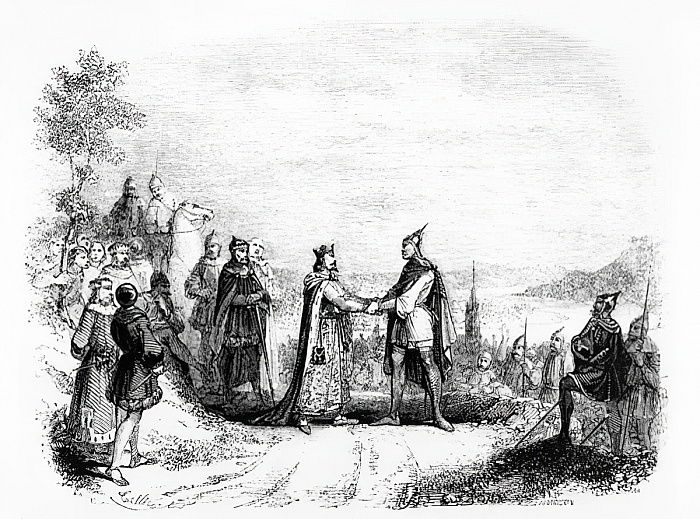
Deutsch-Chinesische Enzyklopädie, 德汉百科
 Military, defense and equipment
Military, defense and equipment










 Military, defense and equipment
Military, defense and equipment




 Military, defense and equipment
Military, defense and equipment
 §***Important peace conferences in world history
§***Important peace conferences in world history

《枫丹白露条约》(Treaty of Fontainebleau),1814年由第六次反法同盟(英国、俄罗斯帝国、普鲁士王国、奥地利帝国)与法国签订的一个条约,拿破仑在此条约中被发配到厄尔巴岛。
拿破仑战争中,1813年英国、俄国、普鲁士和奥地利组成“第六次反法同盟”,10月莱比锡战役中,同盟击败法军,1814年3月倚靠着数倍于法军的兵力占领巴黎,法国投降,拿破仑退位,在枫丹白露宫签署退位诏书,并签订此条约。
1814年4月11日俄国沙皇亚历山大一世、普鲁士国王腓特烈·威廉三世、奥地利皇帝弗朗茨一世签订条约,并于13日交由法兰西第一帝国皇帝拿破仑一世签署。内容是拿破仑一世免去法国皇帝之位,保留帝号,名义上统治厄尔巴岛。
Der Vertrag von Fontainebleau wurde am 11. April 1814 zwischen Napoleon Bonaparte auf der einen Seite und Österreich, Russland und Preußen auf der anderen Seite geschlossen. Das Abkommen regelte die Einzelheiten der Abdankung Napoleons, die noch am gleichen Tag erfolgte. Großbritannien unterzeichnete nur die Teile des Vertrages, die sich auf das zukünftige Schicksal Napoleons und seiner Familie bezogen, weil es Napoleon nie als Kaiser anerkannt hatte.
Der Vertrag erhielt seinen Namen nach dem Ort der Unterzeichnung, dem Schloss Fontainebleau südlich von Paris.




 Military, defense and equipment
Military, defense and equipment




 Military, defense and equipment
Military, defense and equipment
 §***Important peace conferences in world history
§***Important peace conferences in world history

Der Vertrag von Nanking (chinesisch 南京條約 / 南京条约, Pinyin Nánjīng Tiáoyuē) beendete den Ersten Opiumkrieg zwischen Großbritannien und Qing-China im August 1842.
Mit dem Abschluss des Vertrages konnte Großbritannien seine vor Beginn des Krieges formulierten Kriegsziele nahezu vollständig erreichen. Der Vertrag regelte die Annexion von Hong Kong, die Zahlung einer großen Summe als Kompensation, die Abschaffung der bisherigen Rechtspraxis in Handel und Diplomatie sowie die Freilassung aller britischen Staatsbürger in China sowie eine Amnestie für chinesische Kollaborateure. Der Vertrag stellte den ersten der Ungleichen Verträge dar und markiert den Beginn eines krisenhaften Jahrhunderts des chinesischen Staates.
《南京条约》(英语:Treaty of Nanking[2])万年和约”[3],是大清帝国首个因对欧美国家战败而签定的条约。主要条款是大清割让香港岛和开放五口通商。
满清道光二十二年(1842年),大清在对大英的第一次鸦片战争中战败。双方代表在江宁府静海寺谈判并在泊于江宁府下关江面的英军旗舰汗华囇号上签署《江宁条约》。1943年,中华民国国民政府分别与英签订《中英关于取消英国在华治外法权及其有关条约与换文》[4]、美签订《中美新约》,废除一些不平等条约内容,例如治外法权。《南京条约》原件之一由英国政府保存;另一份正本由中华民国外交部保存于台北外双溪国立故宫博物院。[5]
南京条約(ナンキンじょうやく)とは、1842年に阿片戦争を終結させるため、清とイギリスの間で結ばれた講和条約。江寧条約ともいう。
南京条約を記した原本は、のちに中華民国が受け継ぎ、香港返還直前は台北市で一時期展示されていた。
The Treaty of Nanking (Nanjing) was a peace treaty which ended the First Opium War (1839–1842) between the United Kingdom and China on 29 August 1842. It was the first of what the Chinese later called the unequal treaties.[2]
In the wake of China's military defeat, with British warships poised to attack Nanking, British and Chinese officials negotiated on board HMS Cornwallis anchored at the city. On 29 August, British representative Sir Henry Pottinger and Qing representatives Qiying, Yilibu, and Niu Jian signed the treaty, which consisted of thirteen articles. The treaty was ratified by the Daoguang Emperor on 27 October and Queen Victoria on 28 December. Ratification was exchanged in Hong Kong on 26 June 1843. A copy of the treaty is kept by the British government while another copy is kept by the Ministry of Foreign Affairs of Republic of China at the National Palace Museum in Taipei, Taiwan.
Le traité de Nankin est l'accord qui mit fin à la première guerre de l'opium, qui s'est terminée en 1842 par une nette victoire du Royaume-Uni, au côté d'autres puissances occidentales colonisatrices, sur l'Empire chinois de la Dynastie Qing. Le traité ouvre aux Européens de nouvelles possibilités commerciales dans un pays auquel ils n'avaient encore qu'un accès restreint ou militaire. Il ouvre cinq nouveaux ports au commerce dont celui de Shanghai, et proclame la cession de l'île de Hong Kong au Royaume-Uni. La Chine est aussi dans l'obligation de verser des indemnités de 21 millions de dollars sur 4 ans, pour la drogue détruite en 1839. Cet accord fait partie des « Traités inégaux », série de traités imposés militairement par les puissances colonisatrices occidentales aux pays d'Extrême-Orient.
Il fut signé à Nankin le 29 août 1842 à bord d'un vaisseau de guerre britannique, le HMS Cornwallis, par Qiying, Yilibu (zh), et Niu Jian (zh) du côté mandchou et Henry Pottinger du côté britannique.
Il trattato di Nanchino (in cinese 南京條約T, 南京条约S, Nánjīng TiáoyuēP), firmato il 29 agosto 1842, fu una convenzione che segnò la fine della prima guerra dell'oppio (1839-1842) fra l'Impero britannico e l'Impero dei Qing.
El Tratado de Nankín fue un tratado de paz firmado el 29 de agosto de 1842 entre el Imperio británico y la Dinastía Qing que marcó el final de la Primera Guerra del Opio.
Tras la derrota de China en la guerra, los representantes del Imperio británico y de la China de Qing negociaron los términos del tratado a bordo del navío de guerra británico HMS Cornwallis, en aguas de Nankín. El 29 de agosto de 1842, el representante británico sir Henry Pottinger y los representantes de Qing, Qiying, Ilibu y Niujian, firmaron el tratado que consistía en trece artículos que fueron ratificados tanto por la Reina Victoria como por el emperador Daoguang diez meses después.
Нанки́нский договор — договор, заключённый 29 августа 1842 года между Китаем (Цинской империей) и Великобританией, в результате поражения Китая в Первой опиумной войне (1840—1842).
По этому договору к Великобритании отошёл Гонконг[1], Китаем была выплачена огромная контрибуция (ок. 21 000 000 долларов), кроме Кантона открывались ещё четыре китайских порта для иностранной торговли: Амой, Фучжоу, Нинбо и Шанхай.




 Military, defense and equipment
Military, defense and equipment




 Military, defense and equipment
Military, defense and equipment
 §***Important peace conferences in world history
§***Important peace conferences in world history



维克斯-阿姆斯特朗公司的勇士式轰炸机(英语:Vickers Valiant)是英国设计用于携带核武器的高空喷气轰炸机,在20世纪50年代和1960年代是英国皇家空军“V字轰炸机”战略威慑力量的一部分。它是由维克斯-阿姆斯特朗公司根据英国空军部发布的核武装喷气动力轰炸机规范B.35/46开发的。勇士式是“V字轰炸机”中第一种投入使用的轰炸机,随后是胜利者式轰炸机(英语:Handley Page Victor)和火神式轰炸机(英语:Avro Vulcan)。勇士式轰炸机是唯一一种投掷过实弹核武器(用于测试目的)的“V字轰炸机”[1]。
1956年,苏伊士运河危机期间,从马耳他起飞的勇士式轰炸机在埃及上空执行了名为“火枪手行动”的常规轰炸任务。从1956年到1966年初,英勇队的主力在北约和华约国家之间的对抗中发挥核威慑作用。其他中队承担空中加油、空中侦察和电子战任务。
1962年,为了应对苏联地对空导弹技术的进步,包括勇士式在内的V字轰炸机机队从高空飞行改为低空飞行,以避免在高空飞行可能受到的地对空导弹攻击。1965年初,新任国防部长丹尼士·希利决定退役勇士式轰炸机。


 History
History


 Aerospace
Aerospace